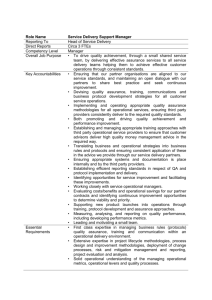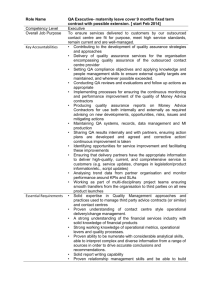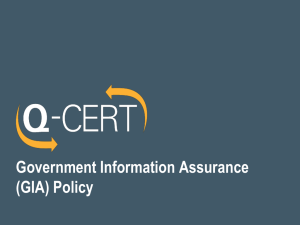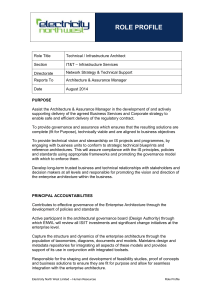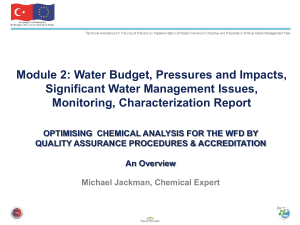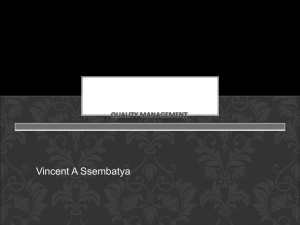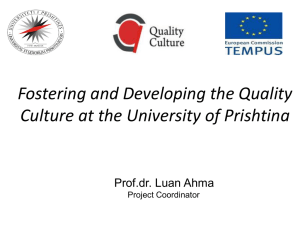What is academic quality assurance in higher education?
advertisement
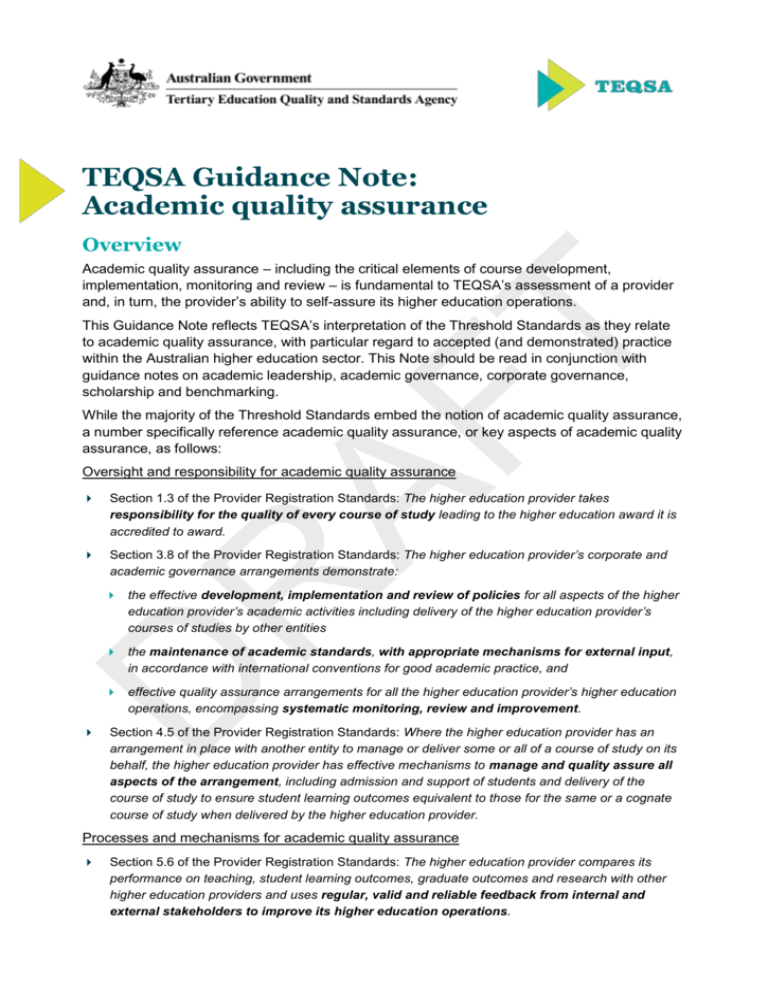
TEQSA Guidance Note: Academic quality assurance Overview Academic quality assurance – including the critical elements of course development, implementation, monitoring and review – is fundamental to TEQSA’s assessment of a provider and, in turn, the provider’s ability to self-assure its higher education operations. This Guidance Note reflects TEQSA’s interpretation of the Threshold Standards as they relate to academic quality assurance, with particular regard to accepted (and demonstrated) practice within the Australian higher education sector. This Note should be read in conjunction with guidance notes on academic leadership, academic governance, corporate governance, scholarship and benchmarking. While the majority of the Threshold Standards embed the notion of academic quality assurance, a number specifically reference academic quality assurance, or key aspects of academic quality assurance, as follows: Oversight and responsibility for academic quality assurance Section 1.3 of the Provider Registration Standards: The higher education provider takes responsibility for the quality of every course of study leading to the higher education award it is accredited to award. Section 3.8 of the Provider Registration Standards: The higher education provider’s corporate and academic governance arrangements demonstrate: the effective development, implementation and review of policies for all aspects of the higher education provider’s academic activities including delivery of the higher education provider’s courses of studies by other entities the maintenance of academic standards, with appropriate mechanisms for external input, in accordance with international conventions for good academic practice, and effective quality assurance arrangements for all the higher education provider’s higher education operations, encompassing systematic monitoring, review and improvement. Section 4.5 of the Provider Registration Standards: Where the higher education provider has an arrangement in place with another entity to manage or deliver some or all of a course of study on its behalf, the higher education provider has effective mechanisms to manage and quality assure all aspects of the arrangement, including admission and support of students and delivery of the course of study to ensure student learning outcomes equivalent to those for the same or a cognate course of study when delivered by the higher education provider. Processes and mechanisms for academic quality assurance Section 5.6 of the Provider Registration Standards: The higher education provider compares its performance on teaching, student learning outcomes, graduate outcomes and research with other higher education providers and uses regular, valid and reliable feedback from internal and external stakeholders to improve its higher education operations. Section 4.2 of the Provider Course Accreditation Standards: The higher education provider ensures that staff who teach students in the course of study … are advised of student and other feedback on the quality of their teaching and have opportunities to improve their teaching. Section 4.5 of the Provider Course Accreditation Standards: The higher education provider has effective arrangements to assure the quality of student work placements, practicums and other forms of work-integrated learning in the course of study, including assuring the quality of supervision. Section 6.1 of the Provider Course Accreditation Standards: The higher education provider ensures the course of study is systematically updated, through internal revision and external reviews, and that its coherence is maintained. Section 4.2 of the Criteria for authorising self-accrediting authority: The higher education provider has highly effective academic governance processes and a robust internal capability to monitor and improve its higher education courses of study. Quality assurance of academic standards and outcomes Section 2.9 of the Australian University Provider Category Standards: The higher education provider has systematic, mature internal processes for quality assurance and the maintenance of academic standards and academic integrity. Section 3.9 of the Australian University College Provider Category Standards: The higher education provider has systematic, well developed internal processes for quality assurance and the maintenance of academic standards and academic integrity. Section 5.3 of the Provider Course Accreditation Standards: Course management and coordination, including moderation procedures, ensure consistent and appropriate assessment. Section 5.4 of the Provider Course Accreditation Standards: The higher education provider maintains, monitors and acts on comparative data on the performance of students in the course of study, including information on the performance of student cohorts by entry pathway, mode of study and place of study, such data to include: student attrition, student progress, course completions and grade distributions. Section 5.5 of the Provider Course Accreditation Standards: The academic standards intended to be achieved by students and the standards actually achieved by students in the course of study are benchmarked against similar accredited courses of study offered by other higher education providers. Section 4.4 of the Criteria for authorising self-accrediting authority: The higher education provider has a history of successful operation of the course/s of study including systematic, mature internal processes for course quality assurance and the maintenance of academic standards and academic integrity. Points of Guidance What is academic quality assurance in higher education? Academic quality assurance is concerned with the core higher education activities of teaching, research and scholarship and is fundamental to assuring and continually improving student DRAFT at 10 July 2014 – Guidance Note – Academic quality assurance | 2 outcomes and experiences and to maintaining academic standards1 and academic integrity. It involves demonstrating and monitoring achievement of a higher education provider’s mission and objectives across all aspects of academic endeavour. As such, it is a practice incorporating collaboration and connectivity across multiple stakeholders’ interests (students, staff, employers, regulation/accreditation bodies and government); learning and knowledge exchange; and leadership commitment – all in the context of a provider’s particular characteristics. Approaches to academic quality assurance need to be effective, efficient and appropriate to the provider’s context and circumstances. Most critically, they need to be effectively implemented. Academic quality assurance points to: consistency and equivalency of student learning outcomes and experiences across delivery locations and different modes of study the availability, appropriateness, adequacy and breadth of services that support academic outcomes mitigation of risk to academic quality across higher education operations maintenance of academic integrity. Academic quality assurance is concerned, at least in part, with all functions relating to the delivery of higher education at every level in an institution – course, school, faculty and institution-wide – and is inextricably related to a provider’s academic and corporate governance arrangements. It requires: systematically planning, resourcing, monitoring and improving of academic practices and processes (such as teaching and learning, assessment, curriculum development, research training, and staff selection) to improve student outcomes collaborative and cross-disciplinary leadership to coordinate activities across academic operations academic staff with appropriate qualifications, teaching skills, experience and academic judgment, and who are committed to scholarly activities and improvement of practice the use of a variety of approaches, methods and instruments which are ‘fit for purpose’ to assist a provider in achieving its institutional mission and objectives a range and variety of monitoring and measurement methods and mechanisms to support regular comparison of performance and evaluation, resulting in reflection and improvement flexibility and variety of approaches to effectively respond to changes and developments in, for example, modes of delivery, student needs, or in discipline areas. Where does responsibility for academic quality assurance reside? A provider’s academic quality assurance responsibility necessarily involves multiple stakeholders – senior management; discipline/academic leaders; academic staff; and staff with responsibility for support services underpinning teaching, research and scholarship. Ultimate The TEQSA glossary of terms at <http://teqsa.gov.au/glossary> contains a definition of ‘academic standards’. Standards may be defined according to discipline or profession and may be national or international. 1 DRAFT at 10 July 2014 – Guidance Note – Academic quality assurance | 3 responsibility for and oversight of academic quality assurance rests with the key academic governance body, such as the academic board, which, in turn, reports to the governing body. Where the delivery of academic programs or higher education support services is outsourced to a third party, clear lines of responsibility should be established which ensure that the provider retains overall accountability for quality assurance and the integrity of all aspects of the outsourcing arrangement, in line with requirements of PRS 4.5. Academic quality assurance in practice Academic quality assurance is multi-faceted and TEQSA recognises that educational providers will approach and pursue academic quality assurance differently and according to their particular natures and objectives. Nonetheless, based on accepted and demonstrated practice, a range of features underpin effective academic quality assurance. Systematic and comprehensive cycles of review: Processes that facilitate critical review and reflective practice in order to better understand, respond to, and improve the quality of academic standards, organisational performance, and the student experience are integral to academic quality assurance. Reviews should: be systematic; draw on a variety of methods; involve internal and/or external expertise; and incorporate external comparisons and input. Collective reflective practice, learning and improvement are fundamental to review processes. Review outcomes are captured and reported upon through the academic governance structure in order to identify areas of good practice as well as issues for improvement and action. Mechanisms are in place to ensure action is taken where required, with clear accountability for that action. Normally it would be expected that reviews would be undertaken cyclically, taking account of governance cycles such as budget, planning and risk management and of external factors such as professional accreditation or regulatory requirements. However, review frequency will be determined, in the main, by the type and scope of review being conducted. Reviews of the effectiveness of moderation of assessment processes would be expected to occur more frequently than reviews of an entire academic unit, for example. Review processes to support academic quality assurance should, ideally, be in place at different levels and cover specific issues: courses and subjects/units – the curricula and courses to be offered; course management and administration; admission requirements; contact hours; assessment; award of credit; the equivalence of student learning outcomes across delivery sites, nationally and internationally; the qualifications, experience and ongoing scholarship of teaching staff; the level of teaching support; and the range, quality and availability of learning resources and systems academic entities, such as schools or departments and associated support areas – staffing profile; academic leadership; academic governance structures; implementation of academic policies; and staff and student feedback individual staff, teams and cross-disciplinary groups – quality of teaching practices; support for scholarly activities; scholarly teaching; research outcomes; professional development outcomes and support; responses to student feedback; and peer review of teaching institution-wide academic systems, processes and practices – the effectiveness of, for example, academic policies (including consistency of implementation across different areas, appropriateness and currency); academic governance arrangements (including reporting structures, composition and terms of reference of committees); planning and risk DRAFT at 10 July 2014 – Guidance Note – Academic quality assurance | 4 management processes; student and staff administrative systems; research and research management; and human resource policies and practices, particularly recruitment and selection of staff with appropriate qualifications and/or professional experience, academic staff promotions, reward and recognition systems, academic staff professional development and performance management, and workload systems. Systematic monitoring and management reporting: Effective academic quality assurance requires a systematic reporting framework that clearly identifies roles, responsibilities and reporting hierarchies, and accountabilities for actions. The reporting framework needs to facilitate regular monitoring by academic governance committees and academic leaders of progress against set objectives2 as well as processes and practices impacting on academic standards and the quality of the student experience. Examples of regular reporting on academic matters include: student progress; student feedback data and analysis; relevant student complaints; staffing profile (by discipline), including data such as total staff, staff qualifications, student/staff ratios, class sizes, employment type and strategies for staff recruitment, retention and development; research supervisor reports (where relevant); and reports from academic committees. Importantly, monitoring and reporting need to result in action which leads to improvement. Flexible and adaptive performance information systems: A variety of mechanisms can be used to capture, analyse, report and disseminate a range of quantitative and qualitative data from different sources within, and external to, the provider. Data should, ideally, be applied at multiple levels – from the institutional through to course or individual levels – as is relevant or as data permits. Examples of data sources include: customised or national student survey tools; external reports (such as those from professional accreditation or registration bodies); qualitative feedback through student/staff consultative committees; employer and industry feedback; analysis of trends arising from student complaints and grievances; external moderation of student learning outcomes; external examiner reports; internal or external review recommendations; national or international benchmarking reports; and self-assessments against good practice points or external standards. Benchmarking: Using a structured, collaborative, learning process for comparing practices, processes or performance outcomes in order to identify comparative strengths and weaknesses as a basis for improvement is important to the maintenance of academic quality. While statistical comparisons are an important part of academic quality assurance, benchmarking involves more than the simple generation of statistical data from a variety of sources, or a ‘tick a box’ exercise. The scope, frequency and methods for benchmarking and the selection of appropriate organisations with which to benchmark will depend on the purpose. Outcomes should be recorded and reported in order to inform decision-making and improvements. (Refer to TEQSA’s Guidance Note on Benchmarking for further information.) Risk identification and mitigation processes: Systematic approaches to the identification of risks at all levels of the organisation, and the identification and implementation of minimisation or mitigation strategies, are essential to the maintenance of academic quality. Risks to academic quality are normally identified at the level of the academic organisational unit (eg school or faculty) and above, and include such factors as: the qualifications and experience of 2 Objectives may include those within a strategic plan or teaching and learning plan, or against expected student learning. DRAFT at 10 July 2014 – Guidance Note – Academic quality assurance | 5 academic staff; academic leadership; moderation of assessment; currency of curriculum materials; staff professional development; provision of learning resources; academic delegations; and the development, implementation and review of academic policies. Clear assignment of responsibility and accountability: Clear responsibilities and accountabilities for academic quality assurance can be articulated through mechanisms such as: formal delegation instruments; terms of reference of academic governance bodies; staff and student charters or similar; position descriptions; policies on academic misconduct/upholding academic integrity; workplans or similar for academic staff; and course management policies/procedures. A student-centric focus: Data to ultimately evaluate the quality of the student experience should encompass student input, capturing the student ‘voice’ in its various forms over time, and should take account of different student cohorts (such as by entry pathway, mode of study, place of study or other groupings such as full-time/part-time, international, domestic, matureaged). Typical performance measures covering the student experience (incorporating input, throughput and output/outcome measures) include: admissions; rates of attrition, progression and completion; achievement of learning outcomes; graduate destinations; and various student satisfaction measures covering aspects of the teaching and learning experience and the learning resources and environment. Use of outputs/outcomes measures to support and demonstrate improvement: Systematic cycles of review, monitoring and reporting processes ought to involve the interrogation, interpretation and analysis of outcomes/outputs indicators and measures to analyse performance and identify opportunities for improvement. Examples include: course completions; student satisfaction data; staff with higher level qualifications; and graduate achievement of learning outcomes. Regular interrogation of data will also assist in identifying trends that may require attention and in highlighting improvements over time as a result of deliberate actions taken to improve and refine processes and practices impacting on outcomes. Under the TEQSA Act, it is the responsibility of each registered provider to meet all of the Threshold Standards at all times, and to be able to demonstrate its compliance through the provision of relevant evidence when required to do so. Outputs and outcomes measures over time provide evidence of processes being in place to produce data and ensure its subsequent use to maintain or improve student learning outcomes and experiences, academic standards, and academic integrity – and to provide evidence of improvements. Things to consider Providers must consider a range of issues in developing academic quality assurance processes and ensuring their sufficiency and appropriate deployment to meet the requirements of the Threshold Standards. Some key considerations include: Are monitoring, review and improvement processes relating to teaching and learning, research (as applicable) and scholarship in place? Are these processes regularised and overseen by dedicated personnel? Is the location of responsibility and accountabilities for implementation and outcomes of academic quality assurance clearly understood throughout the provider? Are review cycles systematic in frequency and approach? Are they conducted variously at all levels of academic operations? DRAFT at 10 July 2014 – Guidance Note – Academic quality assurance | 6 Is the system of academic quality assurance centrally monitored or overseen from within each faculty? Is the system holistic and all-encompassing? Are monitoring, review and improvement processes evaluated cyclically? Are results of review/monitoring activities accessible to staff across the organisation and/or made public? Are findings of student surveys – both negative and positive – published and discussed? Is there monitoring to ensure that processes relating to courses – course development, approval, monitoring and review – are effective in ensuring compliance with external standards and requirements, such as professional accreditation and the AQF? Are results of stakeholder feedback (from students, staff, employers, professional bodies) integrated into decision- and policy-making to enact change and improvement at all levels – unit, course, faculty and organisation? Are the responses at the academic governance, corporate governance and management levels to the findings of monitoring, review and benchmarking processes subsequently applied to drive policy-making? Are information data sets aggregated and results analysed for interrogation by academic governance bodies, senior management and academic leaders? Is there evidence that improvements to academic quality have been realised through the implementation of specific initiatives over time? Are campuses or other delivery sites outside the provider’s main location (including those offshore) subjected to academic quality assurance processes with similar regularity and rigour? Are benchmarking processes monitored to ensure they are effective in maintaining academic quality? Are assessment processes systematically moderated and regularly evaluated for effectiveness? Are systematic processes in place at all levels to prevent misconduct and maintain academic integrity? Are staff aware of the process of quality assurance in their institution, the methods used to monitor quality and how quality assurance is linked to continual improvement of student learning outcomes and experiences? Is this awareness integrated into staff development such that staff understand and enact the role they play in the provider’s academic quality assurance processes? Are students aware of their role in the provider’s quality assurance processes and the importance of their contributions to enhancing their learning experiences? Are students assured of the provider’s intention to deliver a quality learning experience? Does the provider produce evidence to students of its commitment to achieving excellence in teaching? Resources The plethora of resources available relating to various aspects of academic quality assurance includes: DRAFT at 10 July 2014 – Guidance Note – Academic quality assurance | 7 The Office for Learning and Teaching’s Resource Library which contains a collection of higher education learning and teaching materials flowing from projects funded by the Commonwealth of Australia, including those from the Australian Learning and Teaching Council. See <http://www.olt.gov.au/resources/good-practice>. The Quality Code which sets out expectations for providers of UK higher education, available at <http://www.qaa.ac.uk/AssuringStandardsAndQuality/quality-code/Pages/default.aspx>. Academic Quality Agency (New Zealand) – resources for enhancing quality at <http://www.aqa.ac.nz/enhancing-quality/thematic-resources>. COPHE – Australian Higher Education Teaching and Learning Standards: Checklists of inputs and outputs, at <http://cophe.edu.au/policy/discussion-papers/teaching-learning-inputs-andoutputs-tony-shannon/index_html\>. Quality Frameworks: Reflections from Australian Universities: AUQA Occasional Publication, 2004. TEQSA Contact For further information about or discussion of academic quality assurance, providers should contact their case manager in the first instance. DRAFT at 10 July 2014 – Guidance Note – Academic quality assurance | 8

